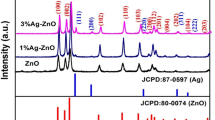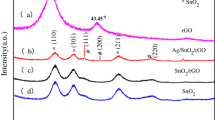Abstract
Sensing mechanism is still a big problem in the field of gas sensor. In-depth study of the sensing mechanism can provide better ideas for the design of sensing materials, and it is also more conducive to the improvement in gas-sensing performance. In this work, Ag/α-MoO3 material was obtained by loading Ag in α-MoO3 nanobelts prepared by hydrothermal method. The material was characterized by field electron scanning electron microscopy (SEM), high-resolution transmission electron microscopy (HRTEM), X-ray diffraction (XRD) and X-ray photoelectron spectroscopy (XPS). Comparing the gas sensing properties of α-MoO3 and Ag/α-MoO3, it is found that Ag effectively improves the selectivity of the material to H2S at 133 °C. The response of the 5 wt% Ag/α-MoO3 sensor to 100 × 10−6 hydrogen sulfide (H2S) is 225 and the detection limit is 100 × 10−9. The sensing mechanism was verified by gas chromatography and mass spectrometer (GC–MS), XPS and Fourier transform infrared spectroscopy (FTIR).








Similar content being viewed by others
References
Park KR, Cho HB, Lee J, Song Y, Kim WB, Choa YH. Design of highly porous SnO2-CuO nanotubes for enhancing H2S gas sensor performance. Sens Actuators B. 2020;302:127179.
Li ZJ, Wang NN, Lin ZJ, Wang JQ, Liu W, Sun K, Fu YQ, Wang ZG. Room-temperature high-performance H2S sensor based on porous CuO nanosheets prepared by hydrothermal method. ACS Appl Mater Interfaces. 2016;8(32):20962.
Kim MH, Jang JS, Koo WT, Choi SJ, Kim SJ, Kim DH, Kim ID. Bimodally porous WO3 microbelts functionalized with Pt catalysts for selective H2S sensors. ACS Appl Mater Interfaces. 2018;10(24):20643.
Bunpang K, Wisitsoraat A, Tuantranont A, Phanichphant S, Liewhiran C. Effects of reduced graphene oxide loading on gas-sensing characteristics of flame-made Bi2WO6 nanoparticles. Appl Surf Sci. 2019;496:143613.
Kim JY, Lee JH, Kim JH, Mirzaei A, Kim HW, Kim SS. Realization of H2S sensing by Pd-functionalized networked CuO nanowires in self-heating mode. Sens Actuators B. 2019;299:126965.
Liu FM, Wang J, You R, Yang ZJ, He JM, Wang CL, Liu A, Wang QJ, Yan X, Sun P, Lu GY. YSZ-based solid electrolyte type sensor utilizing ZnMoO4 sensing electrode for fast detection of ppb-level H2S. Sens Actuators B. 2020;302:127205.
Arachchige HMMM, Zappa D, Poli N, Gunawardhana N, Comini E. Gold functionalized MoO3 nano flakes for gas sensing applications. Sens. Actuators B. 2018;269:331.
Zhang HJ, Meng FN, Liu LZ, Chen YJ. Convenient route for synthesis of alpha-Fe2O3 and sensors for H2S gas. J Alloys Compd. 2019;774:1181.
Xu YS, Ma TT, Zheng LL, Sun L, Liu XH, Zhao YQ, Zhang J. Rational design of Au/Co3O4-functionalized W18O49 hollow heterostructures with high sensitivity and ultralow limit for triethylamine detection. Sens Actuators B. 2019;284:202.
Babu MH, Jiban Podder BCD. Texture coefficient and band gap tailoring of Fe-doped SnO2 nanoparticles via thermal spray pyrolysis. Rare Met. 2019. https://doi.org/10.1007/s12598-019-01278-3.
Fang S, Wang H, Yang JY, Lu SG, Yu B, Wang JT, Zhao CR. Electrochemical preparation of silicon nanowires from porous Ni/SiO2 blocks in molten CaCl2. Rare Met. 2019. https://doi.org/10.1007/s12598-016-0742-3.
Xu YS, Zheng LL, Yang C, Zheng W, Liu XH, Zhang J. Oxygen vacancies enabled porous SnO2 thin films for highly sensitive detection of triethylamine at room temperature. ACS Appl Mater Interfaces. 2020;12(18):20704.
Yang S, Liu YL, Chen T, Jin W, Yang TQ, Cao MC, Liu SS, Zhou J, Zakharova GS, Chen W. Zn doped MoO3 nanobelts and the enhanced gas sensing properties to ethanol. Appl Surf Sci. 2017;393:377.
Yang SL, Wang Z, Zou YN, Luo XT, Pan XM, Zhang XH, Hu YM, Chen KS, Huang ZB, Wang SF, Zhang K, Gu HS. Remarkably accelerated room-temperature hydrogen sensing of MoO3 nanoribbon/graphene composites by suppressing the nanojunction effects. Sens Actuators B. 2017;248:160.
Li YX, Song ZX, Jiang F, Sun Q, Ma F, Wang HR, Chen K. Thermal annealing induced mazy structure on MoO3 thin films and their high sensing performance to NO gas at room temperature. Ceram Int. 2016;42(16):18318.
Wang P, Zheng ZK, Cheng XL, Sui LL, Gao S, Zhang XF, Xu YM, Zhao H, Huo LH. Ionic liquid-assisted synthesis of α-Fe2O3 mesoporous nanorod arrays and their excellent trimethylamine gas-sensing properties for monitoring fish freshness. J Mater Chem A. 2017;5(37):19846.
Datta RS, Haque F, Mohiuddin M, Carey BJ, Syed N, Zavabeti A, Zhang B, Khan H, Berean KJ, Ou JZ, Mahmood N, Daeneke T, Kalantar-zadeh K. Highly active two dimensional α-MoO3-x for the electrocatalytic hydrogen evolution reaction. J Mater Chem A. 2017;5(46):24223.
Zhang HJ, Gao LJ, Gong YJ. Exfoliated MoO3 nanosheets for high-capacity lithium storage. Electrochem Commun. 2015;52:67.
Cho YH, Ko YN, Kang YC, Kim ID, Lee JH. Ultraselective and ultrasensitive detection of trimethylamine using MoO3 nanoplates prepared by ultrasonic spray pyrolysis. Sens Actuators B. 2014;195:189.
Ovsianytskyi O, Nam YS, Tsymbalenko O, Lan PT, Moon MW, Lee KB. Highly sensitive chemiresistive H2S gas sensor based on graphene decorated with Ag nanoparticles and charged impurities. Sens Actuators B. 2018;257:278.
Shen SK, Zhang XF, Cheng XL, Xu YM, Gao S, Zhao H, Zhou X, Huo LH. Oxygen-vacancy-enriched porous α-MoO3 nanosheets for trimethylamine sensing. ACS Appl Nano Mater. 2019;2(12):8016.
Yan SN, Li ZJ, Li H, Wu ZL, Wang JQ, Shen WZ, Fu YQ. Ultra-sensitive room-temperature H2S sensor using Ag–In2O3 nanorod composites. J Mater Sci. 2018;53(24):16331.
Yin HB, Kuwahara Y, Mori K, Cheng HF, Wen MC, Yamashita H. High-surface-area plasmonic MoO3-x: rational synthesis and enhanced ammonia borane dehydrogenation activity. J Mater Chem A. 2017;5(19):8946.
Wang Y, Wang YM, Cao JL, Kong FH, Xia HJ, Zhang J, Zhu BL, Wang SR, Wu SH. Low-temperature H2S sensors based on Ag-doped α-Fe2O3 nanoparticles. Sens Actuators B. 2008;131:183.
Yu TT, Cheng XL, Zhang XF, Sui LL, Xu YM, Gao S, Zhao H, Huo LH. Highly sensitive H2S detection sensors at low temperature based on hierarchically structured NiO porous nanowall arrays. J Mater Chem A. 2015;3(22):11991.
Yu HL, Li L, Gao XM, Zhang Y, Meng FN, Wang TS, Xiao G, Chen YJ, Zhu CL. Synthesis and H2S gas sensing properties of cage-like α-MoO3/ZnO composite. Sens Actuators B. 2012;171–172:679.
Bulemo PM, Cho HJ, Kim DH, Kim ID. Facile synthesis of Pt-functionalized meso/macroporous SnO2 hollow spheres through in situ templating with SiO2 for H2S sensors. ACS Appl Mater Interfaces. 2018;10(21):18183.
Dun MH, Tan JF, Tan WH, Tang MH, Huang XT. CdS quantum dots supported by ultrathin porous nanosheets assembled into hollowed-out Co3O4 microspheres: a room-temperature H2S gas sensor with ultra-fast response and recovery. Sens Actuators B. 2019;298:126839.
Inpan U, Leangtanom P, Phokharatkul D, Wisitsoraat A, Phanichphant S, Kruefu V. H2S gas sensor based on Ru-MoO3 nanoflake thick film. J Nanosci Nanotechnol. 2019;19(3):1780.
Yang SQ, Song ZL, Gao NB, Hu ZX, Zhou LC, Liu JY, Zhang BH, Zhang GZ, Jiang SL, Li HY, Liu H. Near room temperature operable H2S sensors based on In2O3 colloidal quantum dots. Sens Actuators B. 2019;286:22.
He M, Xie LL, Zhao XL, Hu XB, Li SH, Zhu ZG. Highly sensitive and selective H2S gas sensors based on flower-like WO3/CuO composites operating at low/room temperature. J Alloys Compd. 2019;788:36.
Lancaster M, Mow R, Liu J, Cheek Q, MacInnes MM, Al-Jassim MM, Deutsch TG, Young JL, Maldonado S. Protection of GaInP2 photocathodes by direct photoelectro deposition of MoSx Thin Films. ACS Appl Mater Interfaces. 2019;11(28):25115.
Sui LL, Song XX, Cheng XL, Zhang XF, Xu YM, Gao S, Wang P, Zhao H, Huo LH. An ultraselective and ultrasensitive TEA sensor based on α-MoO3 hierarchical nanostructures and the sensing mechanism. CrystEngComm. 2015;17(34):6493.
Kumar JV, Karthik R, Chen SM, Saravanakumar K, Govindasamy M, Muthuraj V. Novel hydrothermal synthesis of MoS2 nanocluster structure for sensitive electrochemical detection of human and environmental hazardous pollutant 4-aminophenol. RSC Adv. 2016;6(46):40399.
Benoist L, Gonbeau D, Pfister-Guillouzo G, Schmidt E, Meunier G, Levasseur A. X-ray photoelectron spectroscopy characterization of amorphous molybdenum oxysulfide thin films. Thin Solid Films. 1995;258:110.
Pondick JV, Woods JM, Xing J, Zhou Y, Cha JJ. Stepwise sulfurization from MoO3 to MoS2 via chemical vapor deposition. ACS Appl Nano Mater. 2018;1(10):5655.
Russell SM, Liu DJ, Kawai M, Kim Y, Thiel PA. Low-temperature adsorption of H2S on Ag (111). J Chem Phys. 2010;133(12):124705.
Yu XR, Liu F, Wang ZY, Chen Y. Auger parameters for sulfur-containing compounds using a mixed aluminum-silver excitation source. J Electron Spectrosc Relat Phenom. 1990;50:159.
Acknowledgements
This study was financially supported by the National Natural Science Foundation of China (Nos. 21771060 and 61271126), the International Science and Technology Cooperation Program of China (No. 2016YFE0115100), Heilongjiang Educational Department (No. RCYJTD201903) and Heilongjiang Touyan Innovation Team Program.
Author information
Authors and Affiliations
Corresponding author
Electronic supplementary material
Below is the link to the electronic supplementary material.
Rights and permissions
About this article
Cite this article
Shen, SK., Cui, XL., Guo, CY. et al. Sensing mechanism of Ag/α-MoO3 nanobelts for H2S gas sensor. Rare Met. 40, 1545–1553 (2021). https://doi.org/10.1007/s12598-020-01647-3
Received:
Revised:
Accepted:
Published:
Issue Date:
DOI: https://doi.org/10.1007/s12598-020-01647-3




